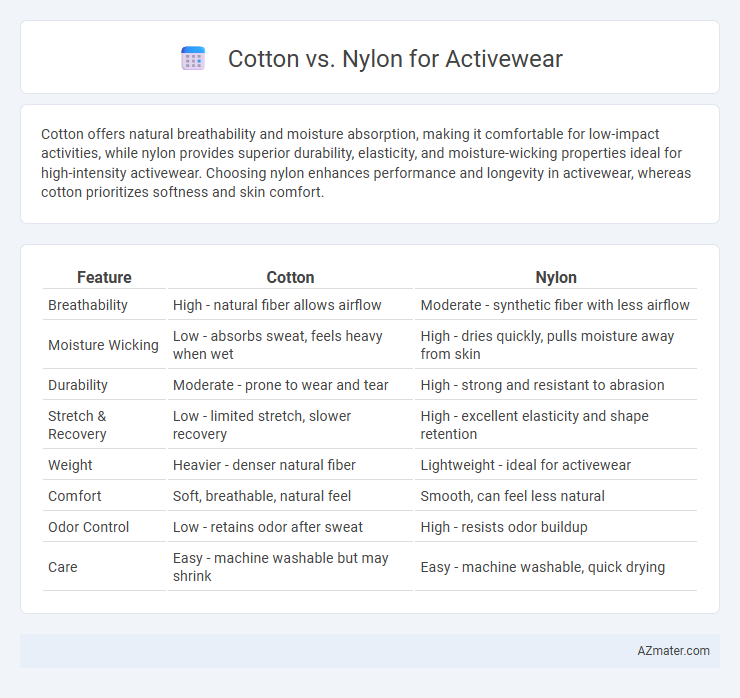Cotton offers natural breathability and moisture absorption, making it comfortable for low-impact activities, while nylon provides superior durability, elasticity, and moisture-wicking properties ideal for high-intensity activewear. Choosing nylon enhances performance and longevity in activewear, whereas cotton prioritizes softness and skin comfort.
Table of Comparison
| Feature | Cotton | Nylon |
|---|---|---|
| Breathability | High - natural fiber allows airflow | Moderate - synthetic fiber with less airflow |
| Moisture Wicking | Low - absorbs sweat, feels heavy when wet | High - dries quickly, pulls moisture away from skin |
| Durability | Moderate - prone to wear and tear | High - strong and resistant to abrasion |
| Stretch & Recovery | Low - limited stretch, slower recovery | High - excellent elasticity and shape retention |
| Weight | Heavier - denser natural fiber | Lightweight - ideal for activewear |
| Comfort | Soft, breathable, natural feel | Smooth, can feel less natural |
| Odor Control | Low - retains odor after sweat | High - resists odor buildup |
| Care | Easy - machine washable but may shrink | Easy - machine washable, quick drying |
Introduction to Cotton and Nylon in Activewear
Cotton is a natural fiber known for its breathability, softness, and moisture absorption, making it comfortable for light to moderate activity but prone to retaining sweat and drying slowly. Nylon, a synthetic fiber, excels in durability, elasticity, and moisture-wicking properties, suited for high-intensity workouts requiring quick-drying and flexible fabrics. Both materials play significant roles in activewear, with cotton favored for comfort and nylon preferred for performance and longevity.
Fabric Composition: Cotton vs Nylon
Cotton fabric, composed of natural cellulose fibers, offers excellent breathability and moisture absorption, making it comfortable for low-intensity activewear. Nylon, a synthetic polymer derived from petrochemicals, provides superior durability, elasticity, and quick-drying properties, ideal for high-performance athletic apparel. The blend ratio of cotton and nylon significantly impacts moisture-wicking efficiency and fabric resilience in activewear applications.
Moisture-Wicking Capabilities
Nylon outperforms cotton in moisture-wicking capabilities, as its synthetic fibers efficiently draw sweat away from the skin, promoting faster evaporation and enhanced dryness during intense workouts. Cotton tends to absorb and retain moisture, leading to a heavy, damp feeling that can cause chafing and discomfort in activewear. Choosing nylon-based fabrics ensures superior breathability and optimal moisture management for high-performance athletic activities.
Breathability and Comfort
Cotton offers superior breathability due to its natural fibers, allowing better air circulation and moisture absorption, which enhances comfort during low to moderate intensity activities. Nylon, although less breathable, provides excellent moisture-wicking properties and durability, making it suitable for high-intensity workouts where quick drying is essential. Choosing between cotton and nylon depends on the balance between breathability and performance needs in activewear.
Durability and Longevity
Nylon outperforms cotton in durability and longevity due to its synthetic fibers, which resist abrasion, tearing, and UV damage better during intense activities. Cotton tends to wear out faster, losing shape and strength with repeated washing and exposure to sweat, making it less suitable for long-term activewear use. Choosing nylon activewear ensures prolonged performance and durability in high-impact and moisture-heavy workouts.
Stretch and Flexibility
Nylon offers superior stretch and flexibility compared to cotton, making it ideal for activewear that requires a full range of motion. Its synthetic fibers provide excellent elasticity and recovery, ensuring garments maintain shape during intense activities. Cotton, while breathable, lacks the resilience and stretchiness of nylon, often resulting in restricted movement and quicker fabric fatigue.
Odor Resistance and Hygiene
Nylon outperforms cotton in odor resistance and hygiene for activewear due to its synthetic fibers that inhibit bacterial growth, which causes unpleasant smells. Cotton tends to retain moisture, creating a breeding ground for bacteria and resulting in faster odor development during intense physical activities. Activewear made from nylon or nylon blends offers better moisture-wicking properties, dries quickly, and maintains freshness longer, making it ideal for prolonged workouts and high-sweat environments.
Environmental Impact and Sustainability
Cotton, especially organic varieties, offers biodegradable qualities and lower microplastic pollution compared to nylon, which contributes significantly to ocean microplastic contamination due to synthetic fiber shedding. Nylon production relies heavily on petrochemicals, resulting in higher greenhouse gas emissions and resource-intensive manufacturing, whereas cotton cultivation demands substantial water usage and pesticide application, challenging its sustainability. Innovations in recycled nylon and organic cotton farming are crucial to mitigating environmental impacts within activewear production.
Price Comparison and Value
Cotton activewear typically costs less upfront but may wear out faster due to lower moisture-wicking and durability compared to nylon. Nylon activewear has a higher price point but offers superior performance, longevity, and moisture management, delivering better value over time for frequent workouts. Investing in nylon garments often reduces replacement frequency, offsetting the initial cost difference with long-term savings.
Best Use Cases: Cotton vs Nylon Activewear
Cotton activewear excels in breathability and moisture absorption, making it ideal for low-impact activities like yoga, walking, or casual wear where comfort and softness are prioritized. Nylon activewear offers superior durability, elasticity, and quick-drying properties, which are best suited for high-intensity workouts, running, and outdoor sports requiring enhanced flexibility and moisture-wicking. Choosing between cotton and nylon depends on the activity intensity, with cotton favored for comfort-focused uses and nylon preferred for performance-driven exercise.

Infographic: Cotton vs Nylon for Activewear
 azmater.com
azmater.com